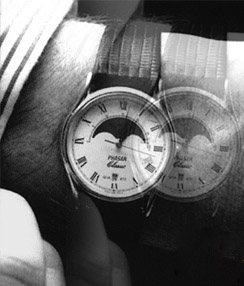Double vision
| Diplopia | |
|---|---|
 |
|
| Photo showing how a patient experiences diplopia | |
| Classification and external resources | |
| Specialty | Neurology, ophthalmology |
| ICD-10 | H53.2 |
| ICD-9-CM | 368.2 |
| DiseasesDB | 31225 |
| eMedicine | oph/191 |
| MeSH | D004172 |
Diplopia, commonly known as double vision, is the simultaneous perception of two images of a single object that may be displaced horizontally, vertically, diagonally (i.e., both vertically and horizontally), or rotationally in relation to each other. It is usually the result of impaired function of the extraocular muscles (EOMs), where both eyes are still functional but they cannot turn to target the desired object. Problems with EOMs may be due to mechanical problems, disorders of the neuromuscular junction, disorders of the cranial nerves (III, IV, and VI) that stimulate the muscles, and occasionally disorders involving the supranuclear oculomotor pathways or ingestion of toxins.
Diplopia can be one of the first signs of a systemic disease, particularly to a muscular or neurological process, and it may disrupt a person’s balance, movement, and/or reading abilities.
One of the first steps in diagnosing diplopia is often to see whether one of two major classifications may be eliminated (both may be present.) This involves blocking one eye to see which symptoms are evident in each eye alone.
Binocular diplopia is double vision arising as a result of strabismus (in layman's terms cross-eyed), the misalignment of the two eyes relative to each other either esotropia (inward) or exotropia (outward). In such a case while the fovea of one eye is directed at the object of regard, the fovea of the other is directed elsewhere, and the image of the object of regard falls on an extra-foveal area of the retina.
The brain calculates the 'visual direction' of an object based upon the position of its image relative to the fovea. Images falling on the fovea are seen as being directly ahead, while those falling on retina outside the fovea may be seen as above, below, right or left of straight ahead depending upon the area of retina stimulated. Thus, when the eyes are misaligned, the brain will perceive two images of one target object, as the target object simultaneously stimulates different, non-corresponding, retinal areas in either eye, thus producing double vision.
...
Wikipedia
